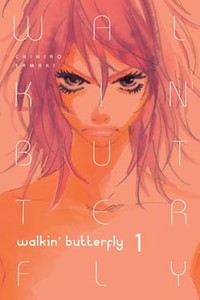Review
by Casey Brienza,Walkin' Butterfly
GN 1
| Synopsis: |  |
||
Michiko is a brash tomboy who loves motorcycles and hates being super tall. While delivering pizzas backstage at a fashion show one day, she is mistaken for one of the runway models and tossed onto the catwalk. Just as the show's designer Ko Mihara warned, however, she cannot hack it and flees in humiliation. Now the proud Michiko is determined to prove Mihara wrong and become a runway model so glamorous that even he will have to acknowledge her. But first, she will need to convince the director of a modeling agency to take her on if she is to take even the first step…and, more importantly still, she will need to learn how to know herself. |
|||
| Review: | |||
If Aurora Publishing were to give Walkin' Butterfly a subtitle, it would be the following: “Where Professional Modeling Becomes a Competitive Sport.” Although technically a josei manga, the series begins as a textbook example of what the painfully hilarious—and painfully honest—classic parody Even A Monkey Can Draw Manga calls the shounen “tournament” formula, which calls for a protagonist who is then subjected to an indefinite number of struggles of increasingly difficulty. As the name suggests, the most common, stereotypical iteration of this formula involves sports storylines such as basketball (Slam Dunk) or baseball (Kyojin no Hoshi), but an identical narrative structure can be creatively shoehorned into tales about board games (Hikaru no Go!), exorcisms (Bleach), ninjutsu (Naruto), and ballet dancing (Swan), just to name a few. Well, now mangaka Chihiro Tamaki has proven that modeling may be added to this already lengthy list. For all intents and purposes, Michiko is a shounen manga hero in drag. Like Naruto, Hikaru, and Hanamichi, she is untried, sincere, and perhaps a bit stupid. She adores motorcycles and mechanics and hates girly fashion. She loses her temper easily. She even soliloquizes with over the top, classic shounen declarations along the arduous path to victory: “Now I'm one step closer to that guy!! I'm closing the distance between us!!” All in all, Michiko's personality and skill set makes her seem singularly ill-fitted to her eventual professional calling, but certain inborn advantages (in Michiko's case, her height) suggest that she will soon be able to draw upon deep wells of heretofore untapped talent. And the plot sure is shaping up into a fun-filled ride that is going to present her with plenty of opportunities to do so. At the beginning of the story, Michiko has, for all intents and purposes, hit a dead end in her life. Her current job is a joke, and she is unable to work up the courage to confess her love to the guy she likes. In short, she needs something—or someone—to light the proverbial fire under her behind. That someone is Mihara, an insufferably supercilious human being who right from the get-go has nothing but contempt for Michiko. He is to her what Sasuke is to Naruto, Rukawa to Hanamichi, Akira to Hikaru, etc.—a worthy rival. (He is also likely to become a love interest since this is a josei manga. This tension between hero and rival can easily be reinterpreted as romance, which explains the prevalence of yaoi fanfiction dedicated to pairing together these two archetypes.) Anyway, the force of his contempt will undoubtedly drive Michiko to greater and ever greater achievement in professional modeling until, at long last, he will acknowledge her as his equal, thereby ending the story. Obviously, nothing here about the plot or the characters is particularly believable or novel. Instead, it is comfortably formulaic; the pleasure of Walkin' Butterfly lies not so much in the discovery of what happens next but rather in how what happens next happens. Modeling is not the most self-evident of tournament manga subjects, yet Tamaki gives it plenty of quirky texture. And she has clearly done her research. She also has a taste for lowbrow humor, which is nearly a prerequisite for levity in a tournament series. (Many jokes come at Michiko's expense.) Finally, it all blends seamlessly with a standard josei manga art style, akin to that of Moyoco Anno or Yayoi Ogawa, which tries to embody the genre's intended sassy, edgy spirit on the page. In this, as in everything else, the art is functional and skillfully executed but not especially exceptional. Outlines are sketchy; backgrounds and screentones are minimal. This brand of art serves the story, not the other way around. One notable oddity is an apparent lack of interest in detailed illustration of fashion. Michiko's motorcycle actually gets more attention! Those hoping to learn about haute couture along with Michiko are likely to be disappointed in the long run. This oversight does not detract unduly from the series, surprisingly. Its subject is modeling, which is an act, not a piece of clothing. Besides, it is not every day that one stumbles across a josei manga that will undoubtedly have both guys and gals alike cheering from the rafters for the protagonist. Run—don't walk—for your copy of Walkin' Butterfly. |
|
The views and opinions expressed in this article are solely those of the author(s) and do not necessarily represent the views of Anime News Network, its employees, owners, or sponsors.
|
| Grade: | |||
Overall : B
Story : B
Art : B-
+ The most popular and proven formula for shounen manga storylines with a novel josei twist. |
|||
| discuss this in the forum (12 posts) | | |||
| Production Info: | ||
|
Full encyclopedia details about Release information about |
||